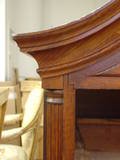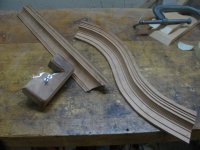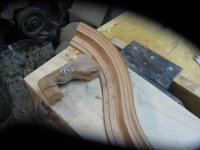Hi Rob:
Looks pretty good. You have a bump in there, right around the inflection point that can be cleaned up by hand, but do that before you go much further. I also see a flat spot below the inflection point. It looks like the registration edge needs a little fine tuning.l As I said earlier, some areas of these mouldings are very sensitive to small errors, and this is one of them. The opposite may be said of the usual requirement to carve the joins between straight and curved sections after assembly. The adjustments will have to be feathered back away from the joint a couple of inches at most, but the human eye forces the perception that the profile is the same along the length of the moulding. I try to make most of the adjustments to the curved mould rather than the straight parts. The eye quickly perceives bumps, but much less so a gradual, small change of profile along the length of a moulding, especially a curved one. This latter condition is what many of us will end up with after the mouldings are installed.
You should also bear in mind that many of the other posters here know a great deal more than I, and have done this many times. I've done it only a few times, but never the same way twice (I think). Do you have the drawings for this feature that I posted on this site a couple of months back? They show the drawing centers of a John Townsend chest on chest, as measured by me. I can send you these by email if you like, if I haven't already. There are three centers to locate. The first two centers are for the gooseneck, the third is for the radius moulding. Starting from the outside edge of the case, the first center is used for the lower half of the gooseneck, and is located directly, or almost so, above the outside edge of the moulding. In this way the lower portion of the moulding goes level just as it terminates, which I believe was the idea behind it. The second center is for the upper portion of the gooseneck, and is controlled by the starting and stopping points of the upper edge of the moulding, where it goes level. The drawing should help, because I can't explain it well here. I won't try to articulate the location principle of the radius mould center, but the drawing should reveal it.
It's been a while since I thought about the geometry of it, but you reminded me that, with respect to the line formed by the upper edge of the moudling, the radius of the upper gooseneck is necessarily different from that of the lower part. Also, for any given radial cross-section, each line will be made with a different radius than its neighbors. This may seem an academic point, but if you derive or know the principles of this layout, you can lay them out simply with drafting tools for any case width and desired bonnet height. Townsend's bonnets rise a third of the case width. Most other Newport pieces rise a good deal more, but my theory allows for any rise in the bonnet you'd like.
I honestly believe that we're looking at something close to sacred geometry here.
JD



